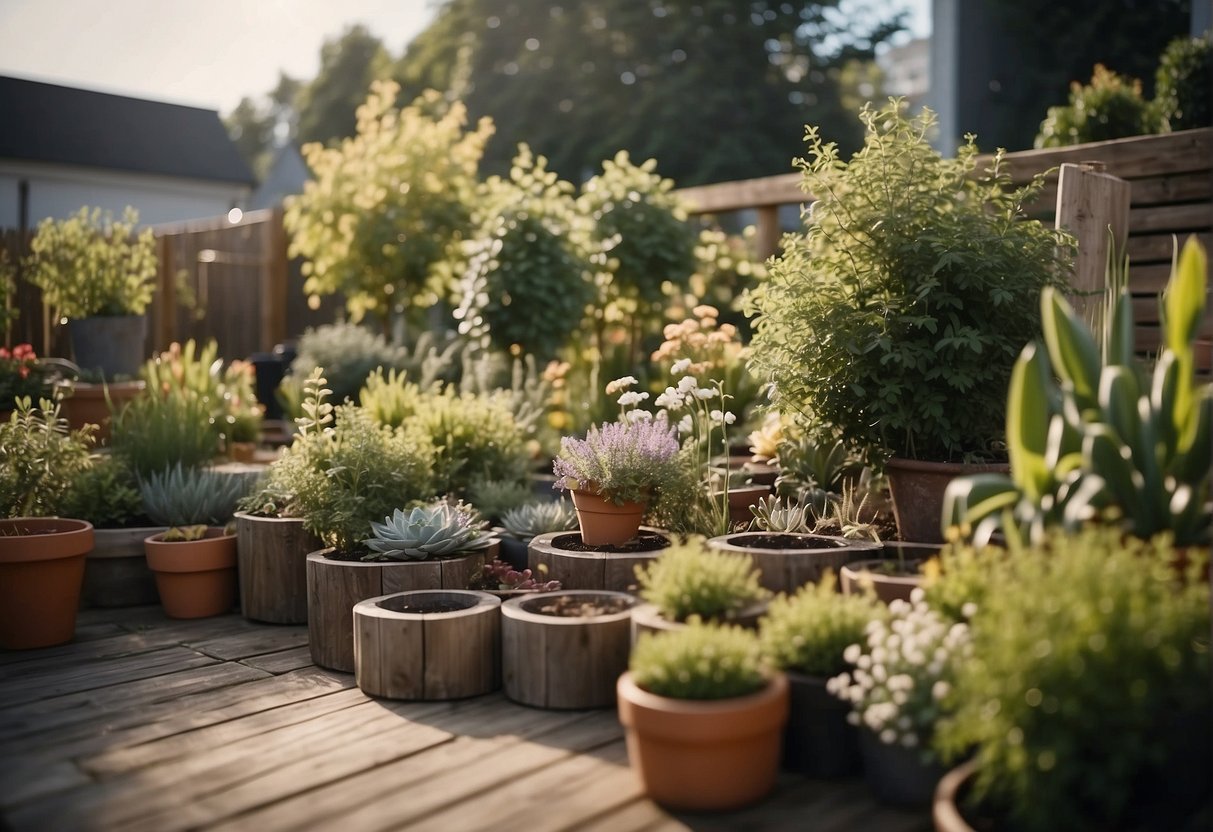Transform Your Outdoor Space Economically
Revamping a garden doesn’t have to empty one’s wallet. With a bit of creativity and some clever repurposing, transforming an outdoor space into a delightful sanctuary can be both economical and rewarding. For those looking to infuse new life into their gardens without the high cost, the secret lies in making strategic choices that maximize impact while minimizing expenses.

One can start by repurposing and upcycling existing materials to serve new functions in the garden space. This eco-friendly approach not only saves money but also adds a unique touch to the garden’s aesthetic. Moreover, using containers for patios or starting a vegetable patch are just a few examples of how one can make significant changes without the need for major investments.
From adding simple decorative touches to undertaking DIY projects, there are a multitude of budget-friendly garden makeover ideas waiting to be explored. These changes not only enhance the look of a garden but may also increase its functionality, providing an enjoyable outdoor retreat that reflects personal style and respects the budget.
Designing on a Dime: Budget-Friendly Garden Layouts

Creating a charming garden doesn’t have to break the bank. With a bit of planning, selecting cost-effective plants, and engaging in DIY projects, anyone can transform their outdoor space into a budget-friendly oasis.
Planning Your Space
When designing a garden on a tight budget, careful planning becomes fundamental. Survey your garden area and consider how each space will be used. Sketch a basic layout map, noting areas for plants, outdoor furniture, and pathways. This not only saves money by avoiding unnecessary purchases but also ensures every inch of your garden is maximized efficiently. Utilizing vertical spaces and multi-functional elements can provide both aesthetic and practical benefits without adding extra cost.
Choosing Budget-Conscious Plants
The selection of plants for a budget-friendly garden should focus on durability and longevity. Opt for native species as they often require less maintenance and are more likely to thrive. Incorporate perennials to enjoy recurring blooms each year, and consider starting plants from seeds or cuttings to save even more. To add a splash of color or fill in gaps, annuals can be a cost-effective option, especially if grown from seed.
DIY Garden Projects
Embrace DIY garden ideas not only as a way to save money but as an opportunity to inject personal flair into your space. Recycle materials like pallets or old tires for raised garden beds or create garden art from repurposed items. Construction projects like a homemade trellis or garden path using found stones or bricks can add both function and charm to your landscape. These projects not only bring uniqueness to your garden but also contribute to a budget-friendly garden design.
Garden landscaping doesn’t have to cost a fortune; with creativity and a willingness to put in some elbow grease, beautiful garden layouts are entirely achievable on a budget. By recycling materials and choosing the right plants, any garden, big or small, can be a source of pride and enjoyment.
The Essentials of Soil and Mulching

Before diving into soil improvement and mulching, one should understand that these are foundational practices for a thriving, budget-friendly garden. They are pivotal for plant health, water conservation, and weed control.
Improving Soil Quality
To enhance soil quality, compost is a gardener’s best friend. They can start their own compost pile to recycle kitchen scraps and yard waste, turning them into a rich soil amendment that supplies nutrients and improves soil structure.
The steps to create compost include:
- Combine green and brown materials in equal parts.
- Ensure proper moisture and aeration.
- Turn the pile regularly to expedite decomposition.
For those on a tight budget, local resources such as coffee grounds from coffee shops or manure from local farms can be useful additions to compost and won’t cost a penny.
Mulching Techniques
Mulching involves covering the soil with organic materials to conserve moisture, suppress weeds, and enhance soil fertility. There are various budget-friendly mulching materials available:
- Straw: Easily spread and great for vegetable gardens.
- Shredded leaves: Can be collected in the fall and provide an excellent, cost-free mulch that also enriches the soil as it breaks down.
Using mulch from landscaping companies can be a cheap yet effective way to obtain mulch. One can build a relationship with a local company and potentially benefit from free or low-cost mulch.
By focusing on these essentials, gardeners can create a sustainable and beautiful garden space without stretching their wallets.
Recycling and Repurposing in the Garden

Gardening enthusiasts can tap into the sustainable trend of using recycled materials to breathe new life into outdoor spaces. Recycling and repurposing can turn everyday items into inexpensive containers and unique garden features, offering an eco-friendly approach that suits any budget.
Creative Container Gardening
One can transform numerous household objects into inexpensive containers for plants. An old bathtub can become a mini pond filled with aquatic plants, while a series of mismatched teacups could serve as charming homes for small succulents. One might consider placing herbs in an over-the-door shoe organizer, creating a vertical hanging planter perfect for small spaces.
- Old boots: Fill with soil and plant flowers.
- Buckets: Drill drainage holes for tomato plants.
- Colanders: Ideal for hanging planters with built-in drainage.
For all containers, ensure proper drainage to keep plants healthy.
Upcycling Items for Garden Features
Repurposing items offers a dual benefit of waste reduction and garden beautification. They can use an antique wrought iron gate to build a trellis or turn wooden pallets into a stylish and functional compost bin.
- Bicycle: Convert into a decorative plant stand with trailing vines.
- Cinder blocks: Stack to create a modern and industrial raised bed.
One can adorn old ladders with potted plants for a tiered display, providing a creative twist while saving floor space. It’s a satisfying way to recycle and add an artistic touch to one’s gardening projects.
Plant Selection: Annuals, Perennials, and Vegetables

When planning a budget-friendly garden, a gardener’s aim is to pick plants that offer both beauty and value. Key considerations include the longevity of perennials, the bright splash of annuals, and the practical utility of vegetables.
Low-Maintenance and Resilient Varieties
For those looking to minimize hassle and expense over time, perennials are a garden’s best friend. They return each year, negating the need to repurchase and replant. Some perennial flowers, like daylilies and sedum, are notable for their hardiness, requiring little care. On the other hand, annuals like marigolds and petunias provide vibrant color at a low cost but will need replacing each year.
Choosing native plants is not only economical but also beneficial for the local ecology. They’re adapted to the regional climate and soil, which means they typically require less water and are more resistant to local pests.
Low-cost perennials include:
- Coneflowers
- Hostas
- Lavender
Budget-friendly annuals:
- Zinnias
- Sunflowers
- Cosmos
Growing Your Own Food on a Budget
Starting a vegetable garden can save money on groceries and provides the freshest produce one can get. Beginning with seeds is more economical than buying young plants. Vegetables like lettuce, carrots, and radishes are cost-effective and can be grown in succession for a continuous harvest.
Container gardening makes it possible to grow food even on patios or balconies. Herbs like basil and chives are perfect for containers, are simple to maintain, and can be harvested throughout the growing season.
Economical vegetables to grow from seed:
- Lettuce
- Green beans
- Tomatoes
Herbs for containers or small spaces:
- Basil
- Mint
- Rosemary
Incorporating both edible and ornamental plants in one’s garden offers multi-season appeal and utility, optimizing the investment and ensuring that one’s garden is not only a feast for the eyes but the table as well.
Accessorizing Your Garden: Affordable Decor and Lighting
Investing in affordable decor and outdoor lighting can transform a garden into a personalized oasis without straining one’s wallet. These additions offer a dual purpose; they serve as practical elements while creating a vibrant aesthetic.
Creating a Focal Point with DIY Decor
Every garden deserves a standout feature that draws the eye and sparks conversation. Garden art need not come with a hefty price tag. An imaginative use of paint can revitalize old items to become eye-catching centerpieces. For instance, they might convert a vintage bicycle into a planter by painting it a bold color and filling its basket with flowers, creating a charming focal point in their garden design.
Functional and Ambient Outdoor Lighting
When the sun sets, gardens can still shine. Affordable outdoor lighting options range from solar-powered stakes that line pathways to string lights that add a gentle glow overhead. They can also repurpose mason jars into lanterns for a touch of whimsy that also provides functional lighting. This not only increases the garden’s usability after dark but also enhances its atmosphere, bathing the space in a soft, ambient light.
Building Structures: Raised Beds, Trellises, and Pathways
When they think about giving their garden a budget-friendly facelift, garden enthusiasts often turn to DIY structures. Constructing raised beds and plant supports or laying down cost-effective pathways not only enhances the garden’s functionality but also its aesthetic appeal.
Constructing Raised Beds and Plant Supports
Building raised garden beds provides ample soil aeration and excellent drainage, making them ideal for nurturing a variety of plants. They can install these using inexpensive or recycled wood to create a defined, fertile space for their garden. Incorporating trellises into the design allows climbers and vines to grow vertically, saving valuable ground area. Websites such as The Spruce offer easy, step-by-step guides for building both raised beds and trellises that are both affordable and functional.
- Materials: Wood (untreated lumber, cedar), concrete blocks, or even repurposed pallets.
- Tools: Hammer, drill, screws/nails, saw (optional for cutting).
- Steps:
- Plan the dimensions based on the available space.
- Assemble the base and walls with chosen materials.
- Attach trellises if needed, using vertical wood pieces or metal rods.
A garden fence, while often thought of as purely functional, can double as a trellis with climbing plants such as ivy or roses draped elegantly upon it.
Pathway Solutions for Every Budget
Pathways not only guide one through the beauty of a garden, they also protect plants from being trampled upon. A budget-friendly pathway can be as simple as laying pea gravel between garden beds, which provides excellent drainage and prevents weeds, creating a neat walkable space. For those looking to add a more decorative touch, patio ideas that incorporate decking material can provide a stable and stylish solution. When selecting materials, they consider longevity and maintenance as well as initial cost.
- Gravel Path: Lay down a fabric weed barrier and spread pea gravel.
- Stepping Stones: Space flat stones evenly over a base of sand for stability and drainage.
- Deck Path: Use reclaimed wood boards to form a straight or winding path.
Think of each pathway as a potential for adding character—whether it mirrors a garden’s rustic charm with natural stone or complements it with polished decking.
Creating these structures can transform a garden from a simple plot of land to a cohesive retreat—with each section crafted as a testament to creativity, resourcefulness, and the homeowner’s connection to the natural world around them.





